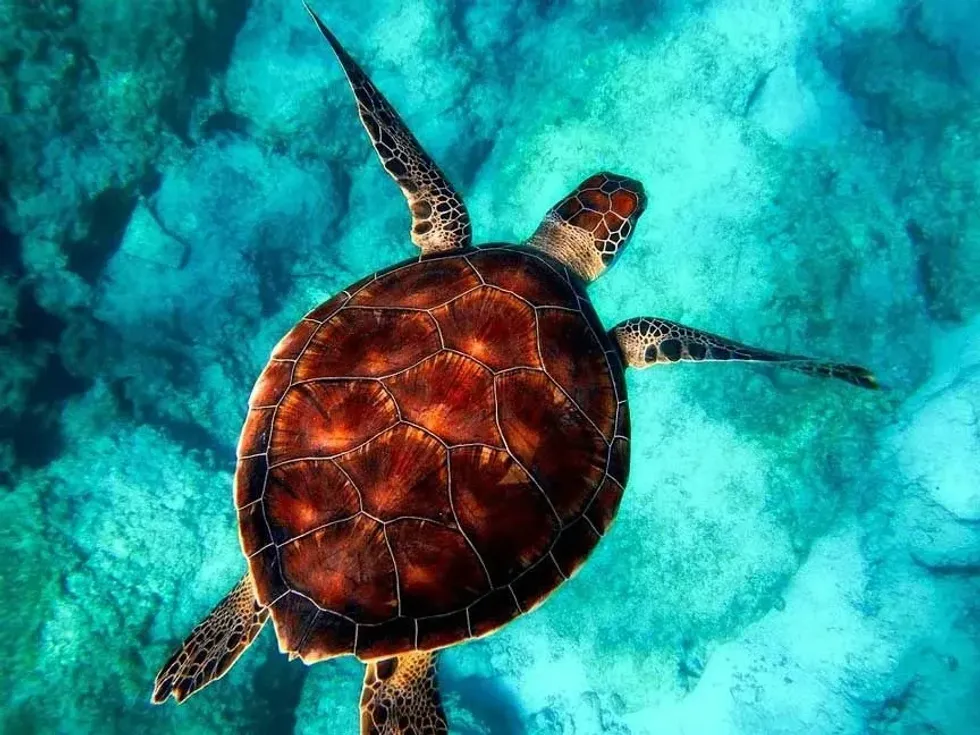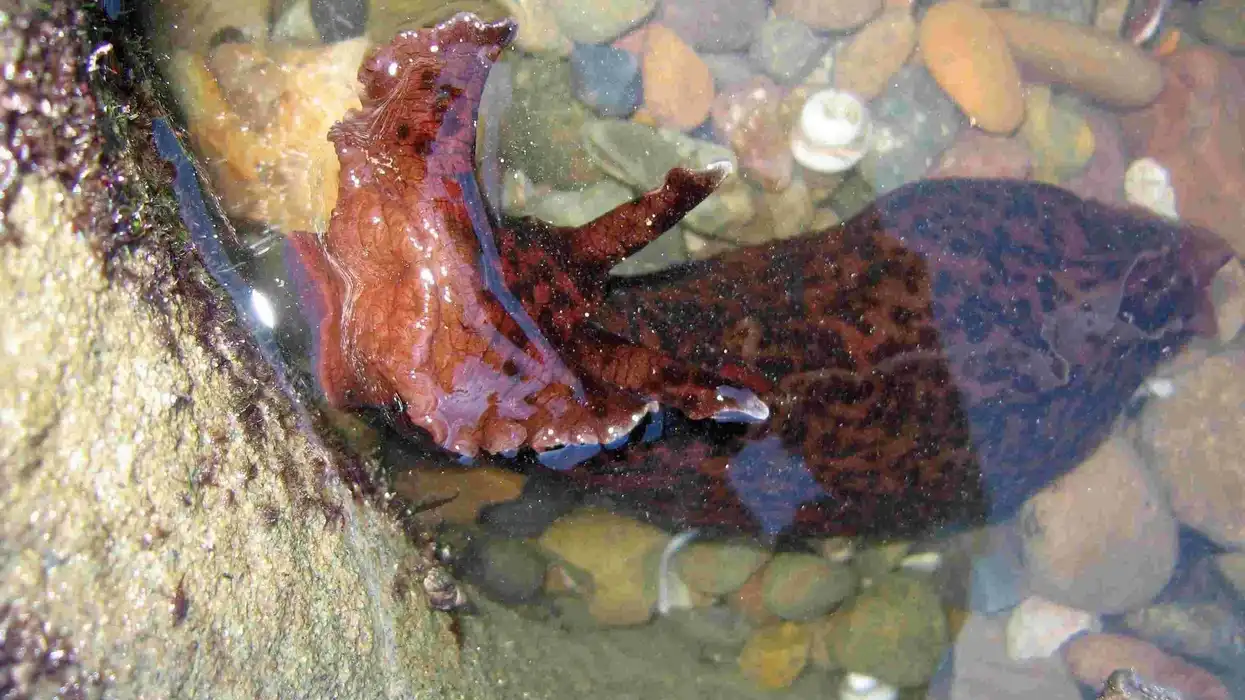Sea turtles are antisocial creatures who love to spend most of their time alone in the sea. Sea turtles are reptiles from the Cheloniidae family.
They are found worldwide and originated from the northern coast of Australia and are spotted around tropical and subtropical beaches. There exist seven species of sea turtles: loggerhead, green sea turtle, leatherback, hawksbill, Kemp's Ridley, Olive Ridley, and flatback.
All species of sea turtles are found in different oceans. For instance, flatback sea turtles are generally found in the Australian oceans, whereas Kemp's Ridley is spotted in the Gulf of Mexico and Eastern parts of the United States. All seven species of marine turtles belong to the Dermochelyidae order.
Sea turtles first appeared on Earth approximately 200 million years ago, and their population is still declining. Sea turtles migrate from their feeding ground to nesting places covering miles.
Sea turtles are marine animals known to be great swimmers. They have limbs and flappers appropriate for swimming but don't work well on land. The sea turtle has sleek heads and stems that cannot pull inside its shell-like other turtles.
The nesting season takes place between March and October, depending on the sea turtle species. The male sea turtle migrates miles to come to nesting beaches during mating season.
Female turtles lay eggs in bunches of 100-200 during the night. They usually use lower mounds to lay their eggs, followed by 40-60 days of incubation. The baby sea turtles (sea turtle hatchlings) become independent soon after they come out of the eggs and try to reach the sea as quickly as possible.
If you enjoy this article, check out leopard tortoise facts and spiny softshell turtle facts.
Sea Turtle Interesting Facts
What type of animal is a sea turtle?
The sea turtle is a type of turtle found in tropical and subtropical regions and belongs to the Chelonia genus.
What class of animals do sea turtles belong to?
Sea turtles belong to the Reptilia class from the Cheloniidae family. They are marine animals found all over the world.
How many sea turtles are there in the world?
There are around 6.5 million sea turtles all over the world. Many reports show a ratio of 3:1 between male and female sea turtles in the world. There are about seven sea turtle species around the globe, out of which only the flatback turtle found in Australia is listed as Critically Endangered.
Where do sea turtles live?
Most of the species are found in the Atlantic, Indian, and Pacific Oceans. A sea turtle's temperature depends on feeding grounds or nesting sites which may vary according to the location and area.
What is a sea turtle's habitat?
Sea turtles, also known as marine turtles, are generally found in oceans, especially open oceans. They prefer living alone within their territories. Adult turtles live in shallow coastal waters, lagoons, and open oceans, whereas juvenile species can be spotted in bays and estuaries.
Sea turtles are found to spend most of their time in the depths of the oceans. They are aquatic animals that prefer living alone in open water areas. Freshwater turtles are found in ponds, lakes, and other freshwater sources.
They don't like living in muddy water. The weather they adapt to is around 82 degrees F (28 C). Climate change is one reason that affects the sea turtle nesting sites.
Sea turtles like eating jellyfish. Green turtles are omnivores that eat coral reefs and algae. They prey on earthworms, grubs, snails, beetles, caterpillars, grasses, fruit, berries, mushrooms, and flowers. Their diet varies from species to species.
They are medium-sized solitary aquatic animals that migrate, covering miles during nesting season toward nesting beaches.
Who do sea turtles live with?
Sea turtles, especially green turtles, prefer living alone within their territories. They do not interact much with other marine animals or even their species. Sea turtles rarely interact during nesting season and spend most of their time under the sea and open ocean.
How long do sea turtles live?
The life span of sea turtles is around 20-30 years. The maximum age they can reach is 50 years, and they can remain sexually active for more than ten years. Sea turtles have a life span close to that of humans.
How do they reproduce?
Sea turtle reproduction usually occurs during the responsive period before the female builds the turtle nesting disclosure. The female turtles usually come back to the nesting beaches, whereas males never return to land once they leave the nesting beaches.
The male turtle bites the back of the female turtle's neck and nudges her head. If female turtles don't go away, the male usually attaches himself to the back of the female's shell by gripping her tight.
He then copulates by folding his tail under her shell. Mating generally occurs in the water or land, and the female lays her eggs in a nest. The average littler size of sea turtles is 50-350 eggs per breeding season, followed by a 60-day incubation period.
The juvenile becomes independent as soon as they hatch from the eggs and many reports also show that the juvenile turtles don't see their mother's faces and make their way to the sea on their own.
What is their conservation status?
According to the IUCN, sea turtles are listed as Endangered or Critically Endangered, depending on the species. There are seven sea turtle species found all over the world.
The hawksbill, leatherback, Kemp's Ridley, and green sea turtles are Endangered, whereas the loggerhead sea turtle falls under Threatened. It is illegal to harm or keep them as pets under the Federal Endangered Species Act of 1973 and Florida's Marine Turtle Protection Act.
Actions such as touching, harassing, harming, or capturing may lead to punishment, or jail even time, under the law.
According to the IUCN-SSC Marine Turtle Specialist Group, sea turtles face five common main threats: fisheries, fishing gear, coastal development, pollution and pathogens, and climate change. They are not aggressive marine animals, but sea turtles have powerful bites and can injure humans.
Sea Turtle Fun Facts
What do sea turtles look like?

The sea turtle is usually spotted in different colors with camouflage patterns depending on their species. They are found in olive-green, yellow, greenish-brown, reddish-brown, or black colors with various patterns.
They have streamlined shells and rounded heads with limbs and flippers that help them to make great swimmers. Sea turtles have internal ears, and their mouth extends way down to the esophagus and gut.
How cute are they?
Sea turtles are cute marine creatures, especially when they are young. A sea turtle has an oily and glossy body, but that won't stop you from petting them. However, their status of being Endangered means that you should keep your distance. They are attractive little creatures with colorful camouflage prints.
How do they communicate?
For many years, scientists have considered sea turtles to be deaf because they don't have vocal cords and internal ears. They communicate by producing low-frequency sounds or hissing sounds.
How big are sea turtles?
There are seven species of sea turtles present all over the world. The largest sea turtle is the leatherback sea turtle, at about 70-86 in (180–220 m) in length, whereas Kemp's Ridley is recorded as the smallest sea turtle species and is around 23–28 in (58–70 cm) in length.
The average length of sea turtles is 24-28 in (62-70 cm). Sea turtles are five to six times bigger than bog turtles.
How fast can a sea turtle swim?
Sea turtles are not considered to be fast swimmers. They can swim up to 0.9-5.8 mph (1.4-9.3 kph). Interestingly, fishing gear is a major threat to Olive Ridley turtles and leatherback sea turtles, and when they come across this gear, their fear can drive them to swim up to 22 mph (35 kph).
How much do sea turtles weigh?
The leatherback turtle, recorded as the largest sea turtle, weighs about 2,019 lb (916 kg). Sea turtles are medium-sized marine animals with an average weight of around 240-420 lb (110-190 kg).
What are the male and female names of the species?
Male and female sea turtles do not have separate names. In general, they are known as the male sea turtle and the female sea turtle. Both look similar and live alone within their areas. Females start nesting and then lay eggs in the same nest with the help of flippers.
What would you call a baby sea turtle?
A baby sea turtle is known as a juvenile turtle. They become independent once they come out of the eggs and try to reach the sea as early as they can.
What do they eat?
The diet of sea turtles differs according to their species. Some are fully carnivorous, herbivorous, or omnivorous and depend on earthworms, grubs, snails, beetles and caterpillars, grasses, fruit, berries, mushrooms, and flowers for their diet.
The diet of the marine turtle varies according to the species. Sea turtles' everyday diet includes crabs, mollusks, shrimps, jellyfish, and vegetation. Loggerhead turtles have very fragile jaws and eat jellyfish, tunicates, and other soft-bodied creatures.
On the other hand, the green sea turtle has a full herbivorous regular diet, consisting of coral reefs, seagrass, and algae.
Are they friendly?
Sea turtles are not friendly, and they don't like interacting with humans and their species. They prefer living alone in their areas and rarely interact during mating season or with other marine animals.
Would they make a good pet?
Sea turtles are not good pets to be kept. Most importantly, it is illegal to keep sea turtles as pets in most countries.
Even if you could keep one as a pet, they require a lot of caring according to their habitat and are not easy to handle a pet. Harbor salmonella is a bacteria that may be passed on to children from sea turtles.
Did you know...
Are you looking for sea turtle facts for kids? Why are sea turtles getting killed? Sea turtles are continuously killed for their eggs, meat, skin, and shells. Almost every sea turtle species is listed as Endangered, and some of them are Critically Endangered.
Sea turtles play a significant role when it comes to symbolism in many cultures. Due to their long lifespan, they are often the symbol of wisdom, patience, luck, and resilience.
Different types of sea turtle
Seven sea turtle species are found worldwide, namely loggerhead sea turtles, green turtles, leatherback, hawksbill, Kemp's Ridley, Olive Ridley, and flatback turtles. Every species is known for its unique features; the leatherback turtle is the world's largest sea turtle, whereas Kemp's Ridley is the smallest.
According to green sea turtle facts, they are entirely herbivorous and eat only plant food. On the other hand, the hawksbill is an omnivore. The flatback turtle is only found in Australia, and the Olive Ridley is also called the Pacific Ridley sea turtle.
What is unique about sea turtles?
Sea turtles have existed on Earth for about 110 million years. They can hold their breath for four to seven hours, especially when sleeping or resting. They fail to breathe underwater naturally, and hence they have to come to the surface for air.
Here at Kidadl, we have carefully created lots of interesting family-friendly animal facts for everyone to discover! Learn more about some other reptiles such as blue-tongued skink facts and map turtle facts.
You can even occupy yourself at home by coloring in one of our free printable sea turtle coloring pages.










